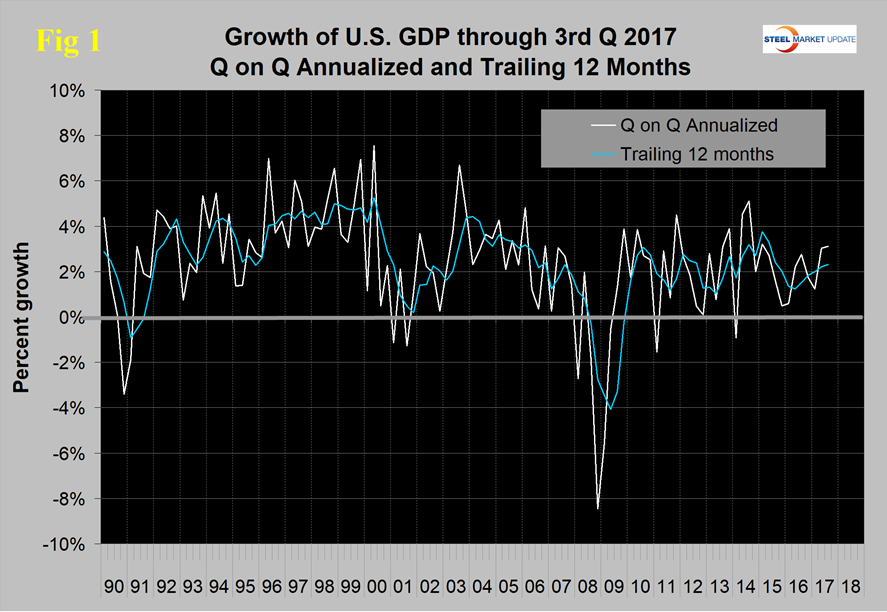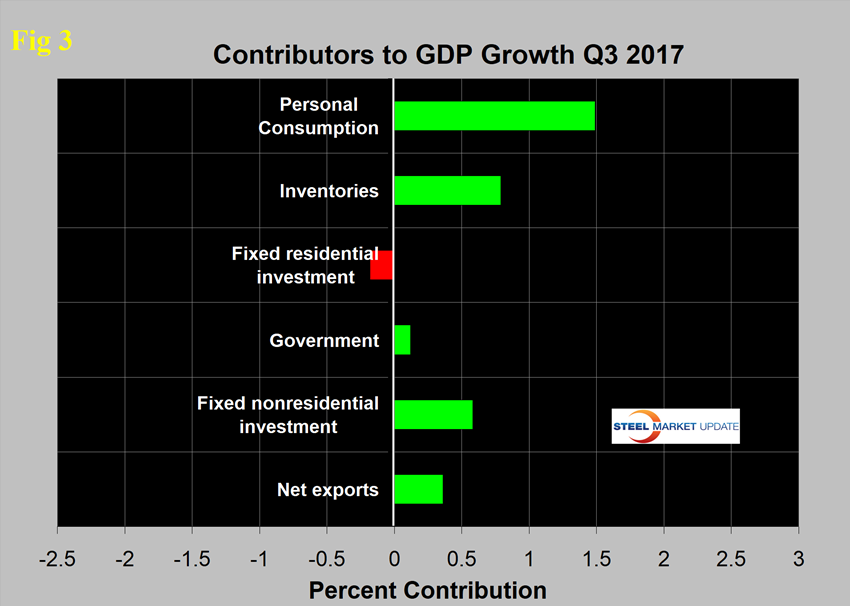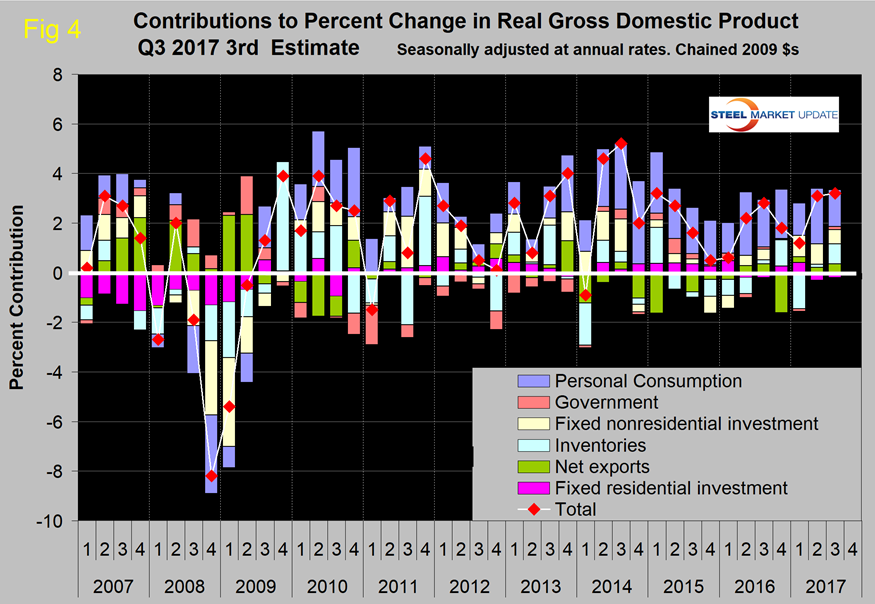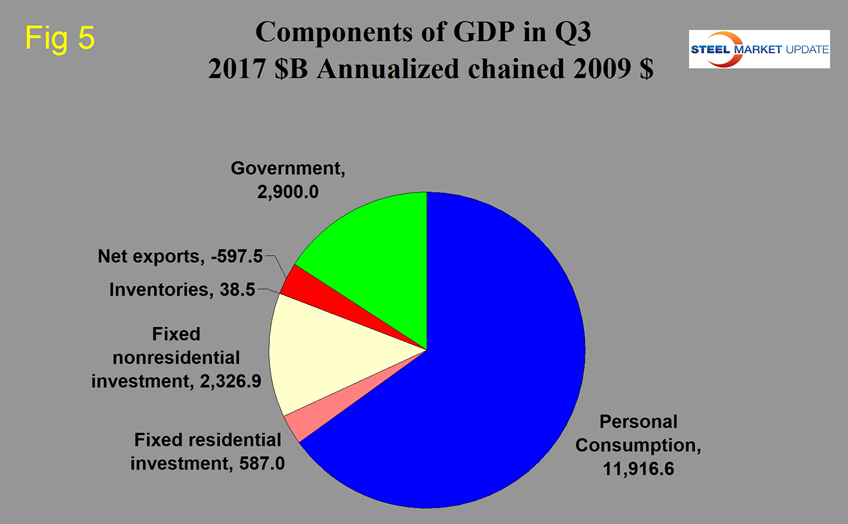Market Data

January 3, 2018
Third-Quarter GDP Stays Strong
Written by Peter Wright
The growth of U.S. Gross Domestic Product in the third quarter of 2017 maintained the strong performance of the second quarter.
On Dec. 20, the Bureau of Economic Analysis released the third estimate of GDP growth in the third quarter. Growth was reported to be 3.16 percent quarter-on-quarter and 2.3 percent year-on-year. At the end of this piece are some expanded definitions of GDP.
Economy.com had this to say about the latest estimate of Q3 GDP: “U.S. GDP growth remained strong in the third quarter, although its composition was less favorable. Real GDP grew 3.2 percent, above the 3.1 percent in the second quarter but below the 3.3 percent reported last month in the third estimate from the Bureau of Economic Analysis. Consumer spending growth slowed and inventory accumulation increased, making its first meaningful contribution to growth this year. Fixed investment and trade also made positive contributions. Hurricane impacts were not quantified by the BEA. Real disposable income grew 0.5 percent after rising 2.7 percent in the second quarter. The saving rate fell to 3.3 percent, its lowest since 2007. Profits rose 4.3 percent (not annualized), after rising 0.7 percent in the prior quarter. Gross domestic income rose 2 percent after rising 2.3 percent in the second quarter. Revisions were minor.”
The final headline report of GDP growth in Q3 came in at 3.16 percent, up slightly from 3.03 percent in the third estimate of growth in Q2. GDP is measured and reported in chained 2009 dollars, and on an annualized basis in the third quarter was $17.164 trillion. The growth calculation is misleading because it takes the quarter-over-quarter change and multiplies by four to get an annualized rate. This makes the high quarters higher and the low quarters lower. Figure 1 clearly shows this effect. The blue line is the trailing 12- months’ growth and the white line is the headline quarterly result. On a trailing 12-month basis, GDP was up by 2.30 percent in Q3, which was close to the 2.14 percent average in 31 quarters since Q1 2010. Therefore, we conclude that the current growth of U.S. GDP is in line with its average for the last seven years.

Figure 2 shows the headline quarterly results since 1990 and the July Congressional Budget Office forecast through 2022. The IMF forecasts global and national economic growth each April and October. In their October update, the forecast of U.S. economic growth was revised down for each year through 2022. Growth in 2017 was revised down from 2.31 percent in the April estimate to 2.18 percent, and down from 2.52 percent to 2.34 percent in 2018.

Figure 3 shows the change in the six major subcomponents of GDP in Q3 2017. Normally, personal consumption is the dominant growth driver, and this continued to be the case in the third quarter. Personal consumption includes goods and services, the goods portion of which includes both durable and non-durables.
The contribution of inventories increased from negative 1.46 percent in Q1 to positive 0.79 percent in Q3. Rising inventories are entered as a positive in the GDP calculation. Note that in the definitions at the end of this piece, inventories are not mentioned. Over the long run, inventory changes are a wash and simply move growth from one period to another. The contribution of personal consumption declined from 2.24 percent in Q2 to 1.49 percent in Q3. Net exports have made a positive contribution in five of the last six quarters, influenced by the decline in the value of the dollar that continued through early September. The contribution of government expenditures has been almost zero in the last six quarters.

Figure 4 shows the quarterly contributors of the six major subcomponents to GDP since Q1 2007. This chart clearly shows the whipsaw effect of inventory changes. Figure 5 shows the breakdown of the $17 trillion economy.


SMU Comment: GDP growth on a year-over-year basis has been very consistent in the last eight quarters, during which it has ranged from 1.23 percent to 2.30 percent—Q3 this year at 2.30 percent being the best result of those eight quarters. Since Q3 2010, there have only been two quarters when the year-over-year growth exceeded 3.0 percent. In July, the Congressional Budget Office forecast much of the same for the next decade. Citing another definition of GDP not included below, it equals the growth in working population multiplied by their productivity, neither of which currently has much momentum.
Definition of GDP: Gross Domestic Product is the value of the goods and services produced by the nation’s economy less the value of the goods and services used up in production.
GDP is defined as Consumption (C) plus Investment (I) plus Government Spending (G) plus [Exports (E) minus Imports (I)] or:
GDP = C + I + G + (E-I)
This equation is known as an identity. An identity is an equality that remains true regardless of the values of any variables that appear within it. That means it is not a guess or an approximation. It is simple reality.
National savings is GDP minus consumption and government spending. That means that investment equals savings plus net exports. If there are no net exports, then money must come back into the U.S. from outside the country to finance investments, along with savings.
Thus, if there is a government deficit, there must be savings by both consumers and businesses, plus capital flows from outside the country, to offset that deficit in order for there to be any money left over for investments.







